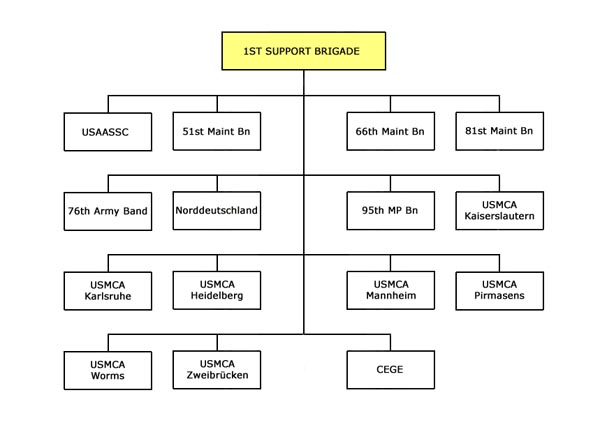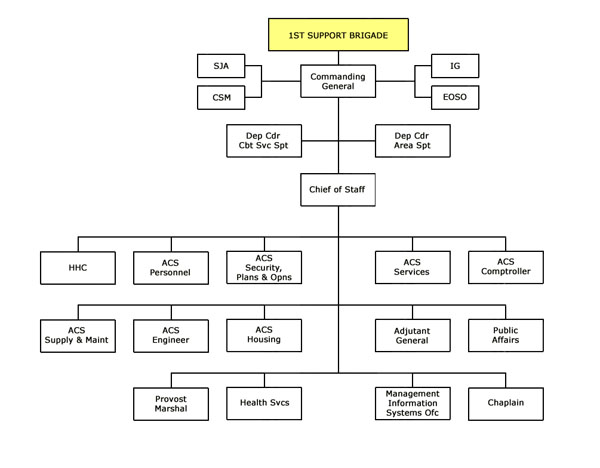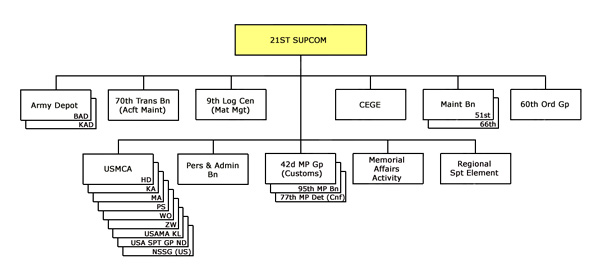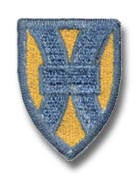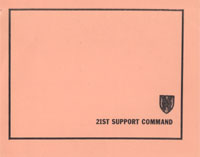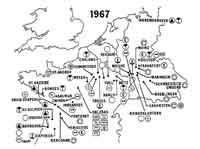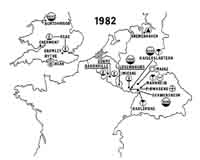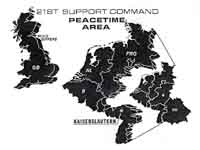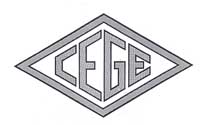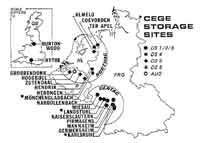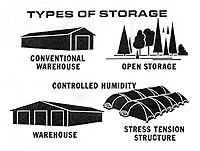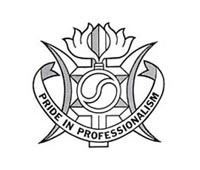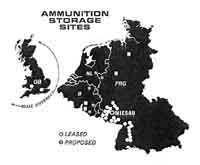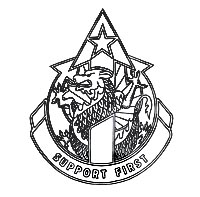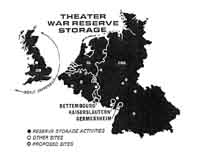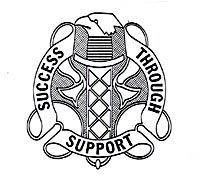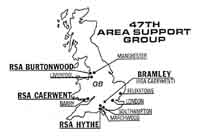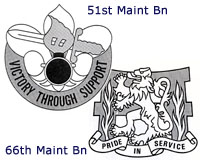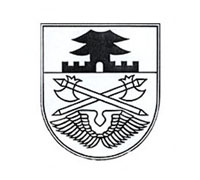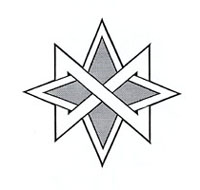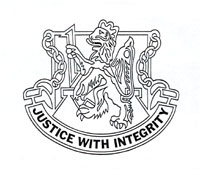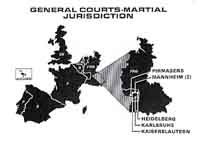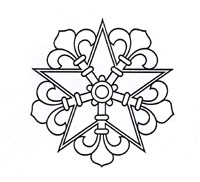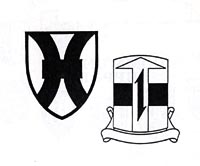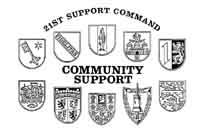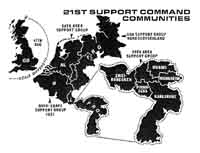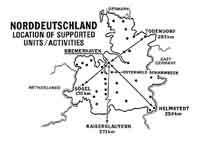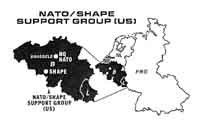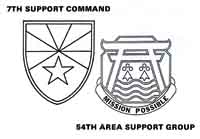If you do
NOT see the Table of Contents frame to the left of this page, then
Click here to open 'USArmyGermany'
frameset |
21st
Support Command
US Army, Europe
Looking for more information from military/civilian
personnel assigned to or associated with the U.S. Army
in Germany from 1945 to 1989. If you have any
stories or thoughts on the subject, please email me (webmaster).
|
|
|
|
|
|
| History |
|
|
|
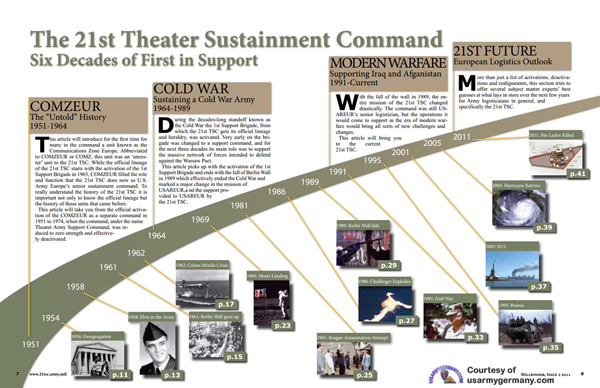
Timeline from 1951 to 2011
|
|
| (Source: 21st Theater Sustainment Command website, accessed July 29, 2013) |
The above issue (Vol 2, 2011) of the MILLRINDER MAGAZINE, is a special issue of the 21st Theater Sustainment Command's publication that features articles on the evolution of the 21st TSC from its roots as the Communications Zone, Europe to its present configuration (2011) and ties the command's 60 year history to many significant milestones in USAREUR & US history.
usarmygermany.com presents two of the main articles that cover the periods 1951 through 1989 as well as a timeline from 1951 to 2011.
To review the entire issue which includes additional articles on the 21st TSC history post-Cold War, click here (the original PDF file is very large - 28 Mb and will take some time to load).
|
|
|
| (Source: 21st Theater Sustainment Command website, accessed April 3, 2012) |
Inheriting a distinguished tradition of combat service support, the lineage and honors of 21st Theater Army Area Command began in 1965 with the activation of the 1st Support Brigade |
|
| 1965 - 1969 |
1st Support Brigade (1st Spt Bde) |
23 June 1965 to August 18, 1976
Mission: The initial mission of the 1st Support Brigade was to provide a variety of support services within theater, primarily in the rear areas, that were not provided directly through the staff of USAREUR, or TASCOM (the 1st Support Brigade would later fall under TSCOM, but initially was a separate element). At this time, the three major Corps operating in theater also had significant Support Commands within their own structures.
Background: The 1st Support Brigade was activated basically to pick up where other theater support units left off. Early the brigade's history, USAREUR conducted a significant restructuring that left no major subordinate logistical command and this place a significant burden of support on the brigade, which soon was upgraded to a command. The brigade's first home was Taylor Barracks, Mannheim, Germany. In 1974, TASCOM was merged with Headquarters, United States Army, Europe, and the missions of 1st Support Brigade were expanded to include base operations support for eight military communities as well as the management of regional area support. The brigade was upgraded to a general officer command, and the headquarters moved to Panzer Kaserne, Kaiserslautern, Germany.
How it is different: As a brigade it was not a major subordinate command. It's capabilities of providing support within its structure did not match that of the preceding organizations of the COMZEUR and the TASCOM, and ultimately USAREUR upgraded the unit to something that much more closely matched the structure of the TASCOM.
|
|
| 1969
- 1988 |
21st Support Command (21st SUPCOM)
August 19, 1976 to October 17, 1988
Mission: The mission of the 21st SUPCOM much more closely resembled that of the TASCOM than the mission of the 1st Support Brigade did. However, at this time, the major Corps operating in theater had significant support commands within their own structure, and the 21st SUPCOM's role was more of a theater wide facilitator than a direct support provider to combat units.
Background: As the 1st Support Brigade's mission set and capabilities continued to increase, USAREUR eventually upgraded the unit to a two-star command and re-designated it as the 21st SUPCOM. This re-designation returned the unit to the status of a major subordinate command to USAREUR, and more accurately reflected the level of responsibility held by the organization.
How it was different: In addition to having logistics capabilities more closely resembling previous organizations like the COMZEUR and the TASCOM, the 21st SUPCOM re-assumed from the USAREUR staff many of the functions that had moved there in the restructuring just a few years earlier. The basic mission of providing support to theater forces, in conjunction with the Corps Support Commands, did not change. |
|
|
| 1988 - 2000 |
21st Theater Army Area Command (21st TAACOM)
October 18, 1988 to October 17, 2000
Mission: Initially the command had essentially the same mission set that had been there for decades: Support theater operations and prepare for war with the Soviet east. Near the end of the 21st TAACOM period, however the mission changed, and the Soviet east was no longer a threat, but support to major operations in neighboring theaters became a significant part of the unit's mission.
Background: The term Theater Army Area Command reflects the unit structure on which the 21st Support Command was already based. In fact, in manning documents, orders and other official documents, the unit name of 21st Support Command was often followed by 'TAACOM' in parenthesis.
How it was different: The name change from 21st Support Command to 21st TAACOM was primarily a name-only change that reflected what was already the unit's official designation. It was upgraded from a two-star to a three-star command, but this was more a reflection of capacity than a significant mission change.
|
|
|
The shoulder sleeve insignia was originally approved on 11 Feb 1966 for the 1st Support Brigade. On 15 Oct 1976 it was redesignated for the 21st Support Command.
|
 |
|
|
|
| Annual
History, 1st Support Brigade, 1974 |
|
|
| (Source: Annual
Supplement to the Unit History of the 1st Support Brigade, 1974) |
1.
Introduction
The Headquarters and Headquarters Company, 1st Support
Brigade was activated on 23 June 1965, as a subordinate
maintenance support headquarters under the Seventh Army Support Command.
The Seventh Army Support Command was an organization reactivated during
the summer of 1965 as part of the program to realign the Seventh Army
logistic structure in accordance with the new COSTAR concept of operations.
This concept of operations centralized the control of all field Army
non-divisional combat service support resources. The 1st Support Brigade
was one of the support brigades so designated under the Seventh Army
Support Command.
The newly formed Brigade Headquarters was organized around the nucleus
of the headquarters of the recently inactivated 521st Engineer Group.
The Headquarters was established at Taylor Barracks, Mannheim-Kafertal,
Germany. The activation and reorganization of the subordinate units
of the Brigade occurred during the period 25 May 1965 through 21 December
1965. Upon reorganization, the Brigade had operational and administrative
control of the following units: 51st Maintenance Battalion (DS), 56th
Supply & Service Battalion (DS), 66th Maintenance Battalion (DS),
81st Maintenance Battalion (GS), 97th Quartermaster Battalion (PETR),
115th Supply & Service Battalion (GS) and the 205th Transportation
Battalion.
As a result of the Command
Control Logistic Study - 1970 (CCLS-70) the Seventh
Army Support Command was dissolved with two support commands, one
assigned to V Corps and VII Corps respectively. The 1st Support Brigade
was reassigned as a major subordinate headquarters under the United
States Theater Army Support Command (TASCOM). On 25 June 1970, there
was a further reorganization and realignment of the supply and maintenance
functions within the Brigade to better adapt to the configuration
of the new TASCOM area of support responsibility. Due to this change,
a number of Brigade missions were realigned within the TASCOM configuration
and the 97th Quartermaster, 115th Supply & Services and the 205th
Transportation Battalions were released from the Brigade. Based on
a feasibility study prepared by a committee from HQ, USTASCOMEUR and
1st Support Brigade, the Commanding General, USTASCOMEUR, approved
a reorganization of all aviation assets within USTASCOMEUR. Under
this reorganization, the Army Aircraft GS/DS Maintenance Support Mission
was assigned to the 1st Support Brigade and the US Army Aviation Maintenance
Center (USAAMAC) was redesignated as the US Army Aviation Systems
Support Center (USAASSC} (PROV) and assigned to the Brigade as a result
of Project
Fender. Upon completion of Project Fender in December
1973 major subordinate units of the Brigade included the US Army Aviation
Systems Support Center, the 51st Maintenance Battalion, 66th Maintenance
Battalion and 81st Maintenance Battalion.
The 1st Support Brigade was the focal point of several important events
in 1974. The Brigade was reorganized under Project
CHASE (Consolidation of Headquarters and Area Support Elements)
moved its headquarters from Mannheim to Kaiserslautern and participated
as a control headquarters for Exercise REFORGER 74.
2. Organization and Administration.
 A. Organization A. Organization
 (1)
Having been reorganized in December 1973 under Project Fender the
Brigade underwent another reorganization on 1 July 1974 under Project
CHASE. Under Project CHASE, area and support functions formerly performed
by TASCOM and ENGCOM were transferred to the communities under the
regional management of the two corps and the 1st Support Brigade.
The resulting organization of the 1st Support Brigade provided for
a dual function headquarters: Combat Service Support (DS/GS Maintenance
and POMCUS Stocks) and Area Support (Community Activities). The 1st
Support Brigade area encompassed most of the former Rheinland-Pfalz
Support and Engineer Districts, Norddeutschland Support District and
residual activities not within the corps Support Regions. (1)
Having been reorganized in December 1973 under Project Fender the
Brigade underwent another reorganization on 1 July 1974 under Project
CHASE. Under Project CHASE, area and support functions formerly performed
by TASCOM and ENGCOM were transferred to the communities under the
regional management of the two corps and the 1st Support Brigade.
The resulting organization of the 1st Support Brigade provided for
a dual function headquarters: Combat Service Support (DS/GS Maintenance
and POMCUS Stocks) and Area Support (Community Activities). The 1st
Support Brigade area encompassed most of the former Rheinland-Pfalz
Support and Engineer Districts, Norddeutschland Support District and
residual activities not within the corps Support Regions.
 (2)
The 1st Support Brigade reorganization was effected under: (2)
The 1st Support Brigade reorganization was effected under:
 (a)
MTOE 54-22G, USAREUR GO 2063, dated 3 April 1974. (a)
MTOE 54-22G, USAREUR GO 2063, dated 3 April 1974.
 (b)
AUG TDA ELWCOG99, USAREUR GO 5225, dated 3 April 1974. (b)
AUG TDA ELWCOG99, USAREUR GO 5225, dated 3 April 1974.
 (3)
The following units remained assigned to 1st Support Brigade: 51st
Maintenance Battalion, 66th Maintenance Battalion, 81st Maintenance
Battalion and USAASSC. (3)
The following units remained assigned to 1st Support Brigade: 51st
Maintenance Battalion, 66th Maintenance Battalion, 81st Maintenance
Battalion and USAASSC.
 (4)
The following units were assigned to Headquarters, 1st Support Brigade: (4)
The following units were assigned to Headquarters, 1st Support Brigade:
|
| UNITS |
|
USAREUR
GO
|
|
DATE
|
|
| USA
Combat Equipment Group, Europe |
|
4723
|
|
26
JUN 74
|
|
| USA
Energy Center, Europe |
|
7472
|
|
20
SEP 74
|
|
| |
|
|
|
|
|
|
The USA Energy Center, Europe was placed under USAREUR for operational
control.
 (5)
The following were attached to Headquarters, 1st Support Brigade: (5)
The following were attached to Headquarters, 1st Support Brigade:
|
| UNITS |
|
USAREUR
GO
|
|
DATE
|
|
| 94th
MP Battalion |
|
4773
|
|
28
JUN 74
|
|
| 95th
MP Battalion |
|
4774
|
|
28
JUN 74
|
|
| RPC
Kaiserslautern |
|
8742 |
|
1
NOV 74 |
|
| RPC
Karlsruhe |
|
8724 |
|
1
NOV 74 |
|
| RPC
Mannheim |
|
7737 |
|
30
SEP 74 |
|
| 15th
AG Det Postal |
|
5538 |
|
24
JUL 74 |
|
| 41st
AG Det Postal |
|
5538 |
|
24
JUL 74 |
|
| 48th
AG Det Postal |
|
5538 |
|
24
JUL 74 |
|
| 111th
AG Det Postal |
|
5538 |
|
24
JUL 74 |
|
| 115th
AG Det Postal |
|
5538 |
|
24
JUL 74 |
|
| 147th
AG Det Postal |
|
5538 |
|
24
JUL 74 |
|
| 5th
Finance Section |
|
4759 |
|
28
JUN 74 |
|
| 44th
Finance Section |
|
4759 |
|
28
JUN 74 |
|
| 45th
Finance Section |
|
4759 |
|
28
JUN 74 |
|
| 59th
Finance Section |
|
4759 |
|
28
JUN 74 |
|
| |
|
|
|
|
|
|
 (6)
The following community activities were established and assigned
to 1st Support Brigade effective 1 July 1974: (6)
The following community activities were established and assigned
to 1st Support Brigade effective 1 July 1974:
|
| USMCA |
TDA |
USAREUR
GO
|
|
DATE
|
|
| Kaiserslautern |
E1W33AAA |
4689
|
|
25
JUN 74
|
|
| Pirmasens |
E1W33GAA |
4694
|
|
25
JUN 74
|
|
| Zweibrücken |
E1W33PAA |
4693 |
|
25
JUN 74 |
|
| Heidelberg |
E1W328AA |
4695 |
|
25
JUN 74 |
|
| Karlsruhe |
E1W33BAA |
4690 |
|
25
JUN 74 |
|
| Mannheim |
E1W33DAA |
4692 |
|
25
JUN 74 |
|
| Worms |
E1W33MAA |
4691 |
|
25
JUN 74 |
|
| USF
SUPDIST Norddeutschland |
E1W28IAA |
4761 |
|
28
JUN 74 |
|
| |
|
|
|
|
|
|
 (7)
The following units were transferred to other USAREUR major commands: (7)
The following units were transferred to other USAREUR major commands:
|
| UNITS |
|
USAREUR
GO
|
|
DATE
|
|
| 48th
Trans Co (Acft GS) |
|
10137
|
|
19
DEC 74
|
|
| 245th
Trans Co (Acft GS) |
|
10138
|
|
19
DEC 74
|
|
| |
|
|
|
|
|
|
 (8)
The configuration of commands within the 1st Support Brigade as
of 1 July 1975 was as follows: (8)
The configuration of commands within the 1st Support Brigade as
of 1 July 1975 was as follows:
|
|
|
 (9)
The Headquarters 1st Support Brigade was organized with the following
command and staff sections: (9)
The Headquarters 1st Support Brigade was organized with the following
command and staff sections:
|
|
|
|
(The
remainder of Section: Organization and Administration is missing.)
|
3.
Major Accomplishments
 A. Operations A. Operations
 (1)
From January 1974 to July 1974, the 1st Support Brigade continued
performing its mission of DS/GS Maintenance support. Of particular
interest was the Combat Equipment Group, Europe (CEGE) CM 5 Program
which was a maintenance repair program on approximately 1300 wheeled
and track vehicles in preparation for Exercise REFORGER 74. (1)
From January 1974 to July 1974, the 1st Support Brigade continued
performing its mission of DS/GS Maintenance support. Of particular
interest was the Combat Equipment Group, Europe (CEGE) CM 5 Program
which was a maintenance repair program on approximately 1300 wheeled
and track vehicles in preparation for Exercise REFORGER 74.
 (2)
US Army Aviation Systems Support Center (USAASSC), in addition to
providing DS/GS aircraft maintenance to the theater area, continued
to provide general support to 1st Support Brigade, USAMMAE, TRANSCOM
and their subordinate units along with operating the USAREUR Closed
Loop program for retrograde and reception of aircraft to USAREUR. (2)
US Army Aviation Systems Support Center (USAASSC), in addition to
providing DS/GS aircraft maintenance to the theater area, continued
to provide general support to 1st Support Brigade, USAMMAE, TRANSCOM
and their subordinate units along with operating the USAREUR Closed
Loop program for retrograde and reception of aircraft to USAREUR.
 (3)
The 51st, 66th and 81st Maintenance Battalions continued to perform
DS/GS maintenance missions in the assigned 1st Support Brigade area. (3)
The 51st, 66th and 81st Maintenance Battalions continued to perform
DS/GS maintenance missions in the assigned 1st Support Brigade area.
 (4)
As a result of the reorganization under Project CHASE, the units
assigned/attached to the 1st Support Brigade as of 1 July 1974 were
transferred with almost no change in mission. The unit transferred
was Combat Equipment Group, Europe (CEGE). Units attached were the
94th and 95th Military Police Battalions. (4)
As a result of the reorganization under Project CHASE, the units
assigned/attached to the 1st Support Brigade as of 1 July 1974 were
transferred with almost no change in mission. The unit transferred
was Combat Equipment Group, Europe (CEGE). Units attached were the
94th and 95th Military Police Battalions.
 (5)
Another facet of Project CHASE was the assumption of the mission
of the third USAREUR Regional Command in addition to V and VII Corps
regions, along with the mission was the assignment and operational
control of seven communities (Heidelberg, Karlsruhe, Kaiserslautern,
Mannheim, Pirmasens, Worms and Zweibruecken) and US Support District
Norddeutschland. The 1st Support Brigade became an organization
with two distinct operational missions: Combat Service Support and
Area Suppurt. (5)
Another facet of Project CHASE was the assumption of the mission
of the third USAREUR Regional Command in addition to V and VII Corps
regions, along with the mission was the assignment and operational
control of seven communities (Heidelberg, Karlsruhe, Kaiserslautern,
Mannheim, Pirmasens, Worms and Zweibruecken) and US Support District
Norddeutschland. The 1st Support Brigade became an organization
with two distinct operational missions: Combat Service Support and
Area Suppurt.
 B.
Training and Exercises B.
Training and Exercises

 (1)
The Brigade conducted its normal unit training during the year with
particular attention being given to attendance at service schools,
i.e., NCO Academy, NCOES and 7th Army Training Center Courses. (1)
The Brigade conducted its normal unit training during the year with
particular attention being given to attendance at service schools,
i.e., NCO Academy, NCOES and 7th Army Training Center Courses.
 (2)
The 1st Support Brigade participated in the following exercises: (2)
The 1st Support Brigade participated in the following exercises:
 (a)
FLAMING LANCE in Sardinia (a)
FLAMING LANCE in Sardinia
 (b)
Vulcan service practice in Crete (b)
Vulcan service practice in Crete
 (c)
ARGUS EXPRESS in Norway (c)
ARGUS EXPRESS in Norway
 (d)
REFORGER 74 (d)
REFORGER 74
 (e)
AUTUMN TEST (e)
AUTUMN TEST
 (3)
REFORGER 74 was the principal exercise during the year in which
the Brigade participated. A provisional command and control organization,
REFORGER 74 Control Group, was established at Worms, Germany in
mid-July 1974. The Control Group moved to Kaiserslautern in early
September, was augmented with representatives from all pertinent
staff sections, began 8-hour per day operations on 2 September and
24-hour operations on 26 September. During the exercise the operation
center staff served as the REFORGER control element of the Brigade.
They maintained current status of equipment and its issue, operational
status and location of REFORGER units and maintained convoy movements,
logistics support and communication. Daily briefings were conducted
for the Brigade Commander and staff. Headquarters, USAREUR was provided
required reports. To assist in the control of 1st Support Brigade
operatio in the MUAA (Major Unit Assembly Area), the 51st Maintenance
Battalion served as the forward liaison element for the Brigade
during Phase II of the exercise. The US Army Combat Equipment Group,
Europe (USACEGEUR) activated and issued track and wheeled vehicles
to REFORGER Forces. The maintenance battalions of the Brigade provided
maintenance, supply and field service support to REFORGER and participating
units in the IUAA's (Initial Unit Assembly Area) and in the MUAA.
In addition to the REFORGER 74 Control Group, other provisional
groups were formed from Brigade and community assets. Assembly Area
Control Groups (AACG) were organized to operate Initial Unit Assembly
Areas (IUAA) in the vicinity of issuing prepo sites during Phase
I and coordinated turn-in and redeployment operations at the storage
sites during Phase II. AACG's were responsible for providing administrative
support and serving as point of contact for all non-organic logistic
support. Convoy Support Centers (CSC) and Maintenance Halts (MH)
were organized from Brigade/Community resources and positioned along
the convoy routes between the IUAA's and the MUAA during Phase I
and Phase III. AC of S Security, Plans and Operations was the focal
noint for all REFORGER 74 actions to include writing, staffing and
publishing the final internal and external after action reports. (3)
REFORGER 74 was the principal exercise during the year in which
the Brigade participated. A provisional command and control organization,
REFORGER 74 Control Group, was established at Worms, Germany in
mid-July 1974. The Control Group moved to Kaiserslautern in early
September, was augmented with representatives from all pertinent
staff sections, began 8-hour per day operations on 2 September and
24-hour operations on 26 September. During the exercise the operation
center staff served as the REFORGER control element of the Brigade.
They maintained current status of equipment and its issue, operational
status and location of REFORGER units and maintained convoy movements,
logistics support and communication. Daily briefings were conducted
for the Brigade Commander and staff. Headquarters, USAREUR was provided
required reports. To assist in the control of 1st Support Brigade
operatio in the MUAA (Major Unit Assembly Area), the 51st Maintenance
Battalion served as the forward liaison element for the Brigade
during Phase II of the exercise. The US Army Combat Equipment Group,
Europe (USACEGEUR) activated and issued track and wheeled vehicles
to REFORGER Forces. The maintenance battalions of the Brigade provided
maintenance, supply and field service support to REFORGER and participating
units in the IUAA's (Initial Unit Assembly Area) and in the MUAA.
In addition to the REFORGER 74 Control Group, other provisional
groups were formed from Brigade and community assets. Assembly Area
Control Groups (AACG) were organized to operate Initial Unit Assembly
Areas (IUAA) in the vicinity of issuing prepo sites during Phase
I and coordinated turn-in and redeployment operations at the storage
sites during Phase II. AACG's were responsible for providing administrative
support and serving as point of contact for all non-organic logistic
support. Convoy Support Centers (CSC) and Maintenance Halts (MH)
were organized from Brigade/Community resources and positioned along
the convoy routes between the IUAA's and the MUAA during Phase I
and Phase III. AC of S Security, Plans and Operations was the focal
noint for all REFORGER 74 actions to include writing, staffing and
publishing the final internal and external after action reports.
 C.
Special Events C.
Special Events
 (1)
Civic Actions (1)
Civic Actions
 (a)
From 12 - 18 May 1974 the annual German-American Friendship Week
was held with open house at Coleman Barracks and Taylor Barracks
in Mannheim. The week was opened by a joint performance at the Mannheim
National Theater. German and American Opera singers participated. (a)
From 12 - 18 May 1974 the annual German-American Friendship Week
was held with open house at Coleman Barracks and Taylor Barracks
in Mannheim. The week was opened by a joint performance at the Mannheim
National Theater. German and American Opera singers participated.
 (b)
From 24 August to 2 September 1974, the 64th MP Detachment, 95th
MP Battalion assisted at the annual Backfischfest in Worms. The
1st Support Brigade Showcase and the 76th Army Band performed there
on 30 September. (b)
From 24 August to 2 September 1974, the 64th MP Detachment, 95th
MP Battalion assisted at the annual Backfischfest in Worms. The
1st Support Brigade Showcase and the 76th Army Band performed there
on 30 September.
2. Permanent Change of Station.
The Brigade completed its move to Panzer Kaserne, Kaiserslautern
during the month of August 1974. A ceremony was conducted on 19
August 1974, which officially established the 1st Support Brigade
in Kaiserslautern. The majority of personnel staffing the headquarters
were reassigned to the 1st Support Brigade from the deactivated
TASCOM, the deactivated Rheinland Pfalz Support District, the deactivated
Rheinland Pfalz Engineer District and the former 1st Support Brigade.
|
|
|
|
(The
remainder of the Annual History is missing.)
|
 |
|
|
|
| Annual
History, 21st Support Command, 1977 |
|
|
| (Source: Annual
Supplement to the Unit History of the 1st Support Brigade, 1974) |
|
|
|
|
|
|
|
|
|
|
 |
|
|
|
| Annual
History, 21st Support Command, 1978 |
|
|
| (Source: Annual
Supplement to the Unit History of the 1st Support Brigade, 1974) |
|
|
|
|
|
|
|
|
|
|
 |
|
|
|
| Command
Briefing |
|
|
|
(Source:
21st Support Command Briefing, prepared by HQ 21st SUPCOM, Kaiserslautern,
probably in 1982 or 1983)
|
|
|
|
21ST
SUPPORT COMMAND
This booklet is unclassified. It is designed to provide
an overview of the missions, organization, operations,
and the scope of the 21st Support Command. |
|
|
|
COMBAT
SERVICE SUPPORT |
| |
|
| |
RECEPTION |
| |
POMCUS
MANAGEMENT |
| |
AMMUNITION |
| |
THEATER
WAR RESERVES |
| |
SUPPLY
& MAINTENANCE |
| |
FIELD
SERVICE |
| |
|
|
|
|
NONCOMBATANT
EVACUATION |
|
|
|
|
|
COMMUNITY
SUPPORT |
|
|
| |
HOUSING
& FACILITIES SUPPORT |
| |
TROOP
& FAMILY WELFARE, MORALE SUPPORT |
| |
|
|
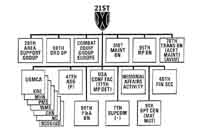 Organizational
Chart
Organizational
Chart |
|
The
21st Support Command is the largest forward deployed logistics
command in the United States Army. Its primary
missions are to support units in and passing through
our region and to provide backup support to the corps. Another
vital mission is to provide community support to its military
personnel, Department of the Army Civilian (DAC) personnel,
and their familities.
It employs 7,000 military and 17,000 civilians. Approximately
90% of the civilians are local nationals. The majority of
military personnel are involved throughout the command in
management and command and control positions.
The command's annual budget approaches one billion dollars. |
| |
|
|
|
|
|
The
present geographical composition of 21st Support Command is
better appreciated after examining a bit of history. Prior
to March of 1967, the COMMZ Europe was USAREUR's logistical
base. It was a proven logistical base born in an era of few
fiscal restraints. At its zenith, its line of communication
across France and West Germany was an impressive logistical
network. After the decision was made that US Forces would
leave France, all facilities with the exception of the pertoleum
pipeline, which is in daily use, were closed out.
See the Logistical
Commands List for pages dedicated
to some of the Com Z units (Com Zone, 4th Log Comd, and others).
|
|
|
|
|
|
|
|
The
USAREUR logistical network changed dramatically from the 1967
COMMZ Europe to its current configuration, shown on the left.
Its mission and workload have increased substantially, and
its boundaries have been radically altered. With the elimination
of a support base in France, all operations were moved into
Germany, the Benelux countries, and Great Britain. In essence,
21st Support Command inherited a logistical battlefield lacking
depth. |
|
|
|
|
|
|
|
Today,
USAREUR has divided the Federal Republic of Germany into three
regions: V and VII Corps support US elements in their geographical
regions of responsibility. 21st Support Command supports US
elements located throughout the remainder of the Federal Republic
of Germany, as well as Great Britain, Belgium, The Netherlands,
and Luxembourg. |
| |
|
THEATER
COMBAT SERVICE SUPPORT |
| |
|
| |
RECEPTION
Exercises/Training/Contingencies |
| |
POMCUS
MANAGEMENT |
| |
STORAGE
& MAINTENANCE OF AMMUNITION |
| |
THEATER
WAR RESERVE STORAGE |
| |
SUPPLY
& MAINTENANCE |
| |
FIELD
SERVICE |
| |
|
|
| |
|
The
Combat Service Support missions of the 21st Support Command
are primarily executed by organic units |
| |
|
|
|
|
|
Combat
Equipment Group, Europe
One
major subordinate unit deeply involved in these functions
is the Combat Equipment Group, Europe (CEGE). Headquartered
at Mannheim, this unique organization has a mission of significant
strategic importance.
CEGE receives, configures, stores, maintains and issues equipment
required to put existing and developing division sets on the
ground in Europe. |
| |
|
|
|
|
|
Two
CEGE battalions located in CENTAG are headquartered at Landstuhl
and Karlsruhe. They store and maintain equipment for division
sets 1 through 3.
In the NORTHAG area another CEGE battalion, headquartered
at Moenchengladbach, stores equipment for division set 4,
for the AFCENT Reserve Corps.
Storage sites for division set 5 equipment, also in NORTHAG,
have been acquired at Grobbendonk and Zutendaal in Belgium
and at Hendrik in The Netherlands, with constrcution already
underway at the Belgian sites.
Negotiations are ongoing for storage sites for division set
6 equipment at Almelo, Coevorden and Ter Apel in The Netherlands. |
| |
|
|
|
|
|
We
use four types of storage for POMCUS equipment. Conventional
warehouses are provided at all POMCUS sites primarily to store
non-mechanized equipment. Open storage is used primarily for
trailers and other equipment unable to be stored in currently
available warehouse space. The best type of storage is controlled
humidity. This is accomplished by warehouses and stress tension
structures.
We have 117 of these (humidity controlled) warehouses in the
Command: 113 in the Federal Republic of Germany and 4 in Belgium.
Inside this type of warehouse (humidity controlled), we store
door-to-door, wall-to-wall, and bumber-to-bumper with only
18" access aisles between equipment.
See
the CEGE
Page for more details on
the Combat Equipment Group Europe. |
| |
|
|
| |
|
POMCUS
AUTHORIZATIONS |
| |
|
| |
Engineer
Mechanical |
18,000 |
| |
Wheeled
Vehicles |
16,000 |
| |
Trailers |
11,000 |
| |
Tracked
Vehicles |
5,000 |
| |
COMMEL |
16,000 |
| |
Crew
Served Weapons |
9,000 |
| |
Other |
277,000 |
|
Total |
352,000 |
| |
|
|
|
| |
|
Our
POMCUS authorizations had an initial acquisition cost in excess
of one billion dollars. This equipment is currently valued
at $3.5 billion. In the category classified as "Other"
are such items as light sets, telephone sets, carpenter and
mechanic tool kits, equipment accessory kits, and pioneer
tool outfits. |
| |
|
|
|
|
|
60th
Ordnance Group
Another
major subordinate unit playing a vital role in 21st SUPCOM's
Combat Service Support mission is 60th Ordnance Group.
|
| |
|
THEATER
AMMUNITION SUPPORT - MISSIONS |
| |
|
| |
 STORE
STORE |
| |
 MAINTAIN / RENOVATE
MAINTAIN / RENOVATE |
| |
 ISSUE
ISSUE |
| |
 EOD
EOD |
| |
|
|
|
|
The
Group's major mission is Theater Ammunition Support.
|
|
|
|
Approximately
75% of the Theater ammunition stockpile, valued at over $2
billion, is stored in diverse locations throughout the Federal
Republic of Germany, Belgium and Great Britain. These sites
store War Reserve Stocks and the basic load of ammuntion for
POMCUS units. The 84th Ordnance Battalion operates the majority
of these sites. Construction planning is ongoing for additional
storage sites to be located in Northern Germany, Belgium,
and The Netherlands.
The key ammunition storage, maintenance, and distribution
center in Germany is Miesau Army Depot, the most active ammunition
depot in the free world, with an ammunition storage capacity
of over 200,000 short tons.
Miesau has the only facility on the continent to maintain
the ammunition stockpile in a serviceable condition.
At a cost of $4.5 million, approximately $60 million of ammunition
was returned to a serviceable condition in FY 81. This resulted
in a cost savings of $13 for each $1 spent.
With its two railheads, Miesau is the hub of the ammunition
distribution system in Germany.
The 60th Ordnance Group also provides explosive ordnance disposal
support in Germany as well as EOD support to the Secret Service
and States Department missions in Europe, the Middle East,
and Africa. This expertise ranges from disarming improvised
terrorist bombs to the rendering safe of both friendly and
enemy chemical, biological, and nuclear weapons. The Group
also provides the ammunition staff for the 21st Support Command.
See the 60th Ord Gp
Page for
more details on the 60th Ord Group and subordinate units.
|
| |
|
|
|
|
|
29th
Area Support Group
Another
major subordinate unit of 21st SUPCOM is the 29th Area Support
Group.
|
| |
|
29th
AREA SUPPORT GROUP - MISSIONS |
| |
|
| |
 THEATER WAR RESERVE STOCKS
THEATER WAR RESERVE STOCKS |
| |
 THEATER ARMY REPAIR PROGRAM
THEATER ARMY REPAIR PROGRAM |
| |
 DS / GS MAINTENANCE
DS / GS MAINTENANCE |
| |
|
|
|
|
|
The
29th Area Support Group has major storage and maintenance
facilities in Kaiserslautern and Germersheim in Germany, and
Bettembourg, Luxembourg.
Theater War Reserve Stocks consist of approximately 400,000
tons of all classes of supply except ammunition and medical.
These stocks are valued at over $1.5 billion. 29th Area Support
Group executes the major portion of 21st SUPCOM's Theater
Army Repair Program.
The Kaiserslautern Reserve Storage Activity stores 172,000
tons of all classes of supply except bulk POL, ammunition
and medical supplies in 35 acres of covered, and 68 acres
of open storage.
Another assigned element of the 29th Area Support Group is
the Germersheim Reserve Storage Activity which stores 175,000
tons of major end items, construction materials, packaged
POL, and repair parts in 13.5 acres of covered and 163 acres
of open storage.
The Reserve Storage Activity, Luxembourg, also subordinate
to the 29th Area Support Group stores 30,000 tons of major
end items and repair parts in 106 acres. Its 19 controlled
humidity warehouses provide over one million square feet of
covered storage space.
See
the 29th
ASG Page for more details
on the 29th Area Support Gp and its subordinate units.
|
| |
|
|
| |
|
Theater
Army Repair Program |
|
|
21st
Support Command, through 29th Area Suppoprt Group, accomplishes
over 90% of the total USAREUR Theater Army Repair Program
in terms of both quantity and dollars. Currently, this involves
in excess of $70 million.
This program supports automotive and construction equipment,
combat items, general items and components, and the ¼-ton
rebuild program.
We operate the direct exchange point for several items including
the 2½-ton multi-fuel and diesel engines. |
| |
|
|
|
|
|
47th
Area Support Group
The 47th
Area Support Group (Provisional), headquartered near Liverpool,
England, is responsible for the execution of our mission in
Great Britain.
|
| |
|
47th
AREA SUPPORT GROUP - MISSIONS |
| |
|
| |
 RECEIVE, STORE, MAINTAIN, AND ISSUE TR-1 AND POMCUS
RECEIVE, STORE, MAINTAIN, AND ISSUE TR-1 AND POMCUS
|
| |
 RECEIVE, STORE, RENOVATE, AND MAINTAIN AMMUNITION
RECEIVE, STORE, RENOVATE, AND MAINTAIN AMMUNITION |
| |
 STORE AND MAINTAIN MARINE FLEET
STORE AND MAINTAIN MARINE FLEET |
| |
|
|
|
|
|
Reserve Storage Activity, Caerwent receives, stores, and maintains
conventional ammunition at its two storage sites, Caerwent
and Bramley, under the supervision of the 60th Ordnance Group.
The Cearwent Storage Site is an ammunition storage and maintenance
activity with a storage capacity of 80,000 short tons of ammunition.
The Bramely Storage Site is located about 50 miles west of
London. It has a capacity of 64,000 short tons of ammunition
and is serviced almost exclusively by rail.
USAREUR's Marine Fleet is stored and maintained at the Reserve
Storage Activity, Hythe.
At the Reserve Storage Activity, Hythe, near Southampton,
we store and maintain the Marine Fleet on 11 acres of land
and 11 acres of water. The watercraft are stored in hangars
and at mooring. We also store and maintain Delong piers and
their associated components.
The Reserve Storage Activity, Burtonwood stores Theater War
Reserve items, medical stocks, and some POMCUS stocks. In
its one covered warehouse at Burtonwood are 47 acres, or over
two million square feet of covered storage space. |
| |
|
|
|
|
|
51st
and 66th Maintenance Battalions
The 21st
SUPCOM provides maintenance and supply support through two
maintenance battalions: the 66th Maintenance Battalion, headquartered
in Kaiserslautern, and assigned to the 29th Area Support Group,
and the 51st Maintenance Battalion with headquarters in Mannheim.
The personnel strength of each of these units approximates
that of three armor battalions.
Their missions include repair, repair parts supply, maintenance
of tactical vehicles to include turret and optical equipment
repair; maintenance of the heavy equipment transporter fleet
and commercial design vehicles, special purpose equipment,
communications and electronics equipment, and small arms repair.
These missions include direct and general support of all POMCUS
equipment.
The maintenance battalions operate local national apprentice
schools to support our work force in both Kaiserslautern and
Mannheim. Additionally, the 66th Maintenance Battalion has
an apprentice program for local nationals which helps us to
overcome mechanic shortfalls.
Each battalion has a supply and services company providing
mobile laundry, shower and bath, canvas repair and supply
support.
See
the 51st
Maint Bn Page and 66th
Maint Bn Page for more details on these two organizations
and their subordinate units.
|
| |
|
|
|
|
|
70th
Transportation Battalion
The 70th
Transportation Battalion, headquartered in Mannheim, is our
aviation intermediate maintenance activity. They provide the
highest level of aviation maintenance and supply for the Army
in Europe.
Although each corps has an aviation intermediate maintenance
battalion, the 70th is the only one with the capability to
perform maintenance on both fixed wing and rotary wing aircraft.
It also operates the Army Aircraft Retrograde Facility at
Ramstein Air Base.
Additionally, they operate Coleman Army Airfield in Mannheim,
the busiest army airfield in Europe. The 56th Theater Army
Aviation Company, located in Mannheim, provides air transportation
within the command area.
The 207th Aviation Company, another of the Battalion's units,
is located at the Heidelberg Army Airfield. They have the
mission of providing aerial movement support to the Commander,
US Army, Europe and his staff.
These companies account for approximately 16,500 hours of
flight time per year, throughout USAREUR.
See
the 70th
Trans Bn Page for more details
on the 70th Trans Bn (AVIM) and its subordinate units.
|
| |
|
|
|
|
|
95th
Military Police Battalion
Another
subordinate unit of 21st Support Command, the 95th MP Battalion,
provides such functions as law enforcement, crime prevention,
traffic control, and traffic accident investigation, as well
as tactical exercise support, physical security, discipline,
law and order, and other related military police missions.
See
the 95th MP Bn Page
(not available yet) for more details on the 95th MP Bn and
its subordinate units.
|
| |
|
|
|
|
|
US
Army Area Confinement Facility Mannheim
Also subordinate
to 21st SUPCOM is the only stockade in Germany: the US Army
Area Confinement Facility located at Coleman Barracks, Mannheim.
This facility, operated by the 77th MP Detachment, supports
USAREUR commanders in pre- and post-trial confinement. Approximately
2,400 prisoners are processed annually while the average daily
population is approximately 190 prisoners. With few exceptions,
post-trial prisoners are transferred to the United States.
The only long-term prisoners are those held pending trial
in foreign courts. |
| |
|
|
|
|
|
Under
the area jurisdiction concept, the Commanding General, 21st
Support Command, is the general courts-martial convening authority
for over 32,000 soldiers in our area of responsibility, shown
on the left. We provide total legal support in military justice,
administrative law, international law, legal assistance, and
claims. |
| |
|
|
|
|
|
90th
Personnel and Administration Battalion
The 90th Personnel and Administration Battalion has its headquarters
in Kaiserslautern.
They provide personnel service support through four personnel
service companies to over 70,000 soldiers, civilians, and
family members from 11 separate commands located in 21st SUPCOM's
area of responsibility.
|
| |
|
|
| |
|
US
Army Memorial Affairs Activity, Europe
The United
States Army Memorial Affairs Activity, Europe, is headquartered
in Frankfurt and provides authorized mortuary services. Its
three mortuaries are located in Frankfurt and Kaiserslautern,
Germany and Vicenza, Italy. |
| |
|
|
|
|
|
|
| |
|
COMMUNITY
SUPPORT |
|
|
|
|
|
|
|
The
other major mission of 21st Support Command is the support
of people, or community support. This includes such vital
areas as noncombatant evacuation, housing, troops and family
welfare, and morale support. |
|
|
|
|
|
|
|
Through
our various community activities, 21st Support Command provides
support to over 105,000 personnel including military, DAC's
and family members. Our noncombatant evacuation responsibility
includes approximately 62,500 identified 21st SUPCOM personnel
in the Federal Republic of Germany. However, the total number
of evacuees we expect to handle would be significantly increased
by noncombatants serving in other governmental agencies, students,
tourists, businessmen, and retirees. |
|
|
|
|
|
|
|
Each
of our communities provide a wide variety of morale support
activities (community & skill development activities,
library activities and physical activities), educational services
and other Army Community Services.
Chaplain programs are provided throughout the command.
Community support operations provide the 21st Support Command
with significant challenges. |
|
|
|
|
|
|
|
These
challenges are especially significant in our most wide-spread
community, Norddeutschland Support Group. Some units supported
are nearly 300 km from the headquarters in Bremerhaven, which
is about 600 km from our headquarters here in Kaiserslautern.
The Group is responsible for providing both combat service
support and community support in its region. |
|
|
|
|
|
|
|
Our
NATO SHAPE Support Group is also wide-spread. This command
provides support to the three major NATO headquarters and
all US Forces personnel in Belgium and Luzembourg. Full civilian
personnel services are provided for NATO personnel in all
countries of the NATO alliance outside of the Federal Republic
of Germany. |
|
|
|
|
|
|
|
Future
plans for expansion involves a number of organizations. For
example, the 7th SUPCOM, presently colocated with the 21st
SUPCOM, will be relocated to the NORTHAG area. The newly activated
54th Area Support Group will eventually assume responsibility
for the AFCENT Support Activity (US) and plan and provide
for logistical and community support of US Forces, affiliated
agencies and families members within their area.
The geographical focal point for the establishment and development
of this planned course of action is located at the Rheinberg
facility. |
|
 |
|
|
|
| Newspaper
articles |
| |
|
(Source:
Support Sentinel, August 28, 1986)
|
21st SUPCOM
traces its roots to World War II support units
If you wear the "First in Support" patch, you ought to know a bit
of 21st Support Command history.
The 21st SUPCOM stems from several organizations that supported the
U.S. Army in Europe during World War II.
It traces its history to May 24, 1942, when the Services of Supply,
European Theater of Operations (ETO) was established in England with
Lt. Gen. John C.H. Lee as its first commanding general. Two years
of buildup and stockpiling of supplies and equipment culminated in
May 1944 when the command was redesignated the Communications Zone,
ETO.
Lee moved his headquarters to France soon after D-day, June 6, 1944,
and, during ensuing months, logistical miracles were performed. The
World War II soldier was supplied and resupplied at a rate and with
efficiency never before attained.
By the time V-E Day, May 8, 1945, rolled around the command had furnished
more than 21 million tons of vital supplies to 61 combat divisions
of the Allied Expeditionary Force, commanded by General of the Army
Dwight D. Eisenhower.
When the colors were furled in January 1946, the World War II command's
logistical feats had attained the status of legend. Allied battle
commanders were unanimous in praising the efficiency and ingenuity
of the American logistical system.
In less than five years, the need for a larger combat support operation
arose with the communist blockade of Berlin in 1948-49. The North
Atlantic Treaty Organization was formed, and Allied Command, Europe,
was established. However, the line of communications had to be expanded
to supply the U.S. Forces committed to the alliance and to maintain
them in a state of combat readiness in Europe.
On April 6, 1950, Brig. Gen. Mason J. Young assumed the task of shaping
a peacetime U.S. Army Communications Zone, Europe (COMZ). By Nov.
6 of that year, an agreement had been reached between the U.S. and
French governments under the terms of which the U.S. was to organize,
staff and maintain a line of communication across France from its
Atlantic ports in the southwest to the German border in the northeast.
COMZ became a vast network of ports, depots, maintenance plants and
administrative and communications facilities. In spite of crises and
potential crises, COMZ never broke its stride. It continued to provide
the supplies necessary to support U.S. Forces during the Lebanon crisis
in 1958 and the buildup of U.S. Forces in Europe following construction
of the Berlin Wall in 1961.
Then, in the spring of 1966, came the decision by French President
Charles de Gaulle that all Allied forces must move out of France by
April 1, 1967. For COMZ this meant moving about 70,000 people and
700.000 tons of supplies in slightly more than 11 months. On Feb.
27, 1967, COMZ (Forward) was established at Worms. Germany, and the
mammoth task was done.
Ninety days later the mission and responsibilities of COMZ (Forward)
doubled when it absorbed the U.S. Army Area Command. In 1968, Operation
CORD (COMZ Realignment of Districts) merged the former Area Command's
10 districts into five U.S. Forces Support Districts (SUPDISTs), streamlining
area support functions.
On April 25, 1969, the command was redesignated the U.S. Theater Army
Support Command, Europe (TASCOM).
The TASCOM was merged with USAREUR headquarters in 1974 and its former
logistical functions were divided among V Corps, VII Corps and the
1st Support Bde. The brigade was activated in 1965 as a maintenance
support headquarters under the 7th Army Support Command and, in 1970,
was made a major subordinate headquarters under the TASCOM.
Also in 1974, the brigade headquarters moved from Taukkunen Barracks,
Worms, to a temporary location in Mannheim and later to Panzer Kaserne,
Kaiserslautern. Brig. Gen. James M. Templeman, former TASCOM deputy
commanding general for area support, assumed command of the brigade
from Col. Story C. Stevens.
Upgrading of the brigade command position to a general officer was
a result of the command's greatly expanded mission under USAREUR.
On Aug. 19, 1976, after a continuous growth in assignment of missions,
geographical areas and organizations, the 1st Support Bile was redesignated
the 21st Support Command, and the graded of its commander was raised
to major general. In 1982 the grade of its commander was raised to
lieutenant general.
Still more missions and activities continued to be added, until today,
the 21st SUPCOM consists of some 32,500 military and civilian personnel
assigned to more than 100 units and activities in Belgium, Luxembourg,
the Netherlands, the United Kingdom, and much of the Federal Republic
of Germany. |
 |
|
|
|
Related
Links
|
| |
|

